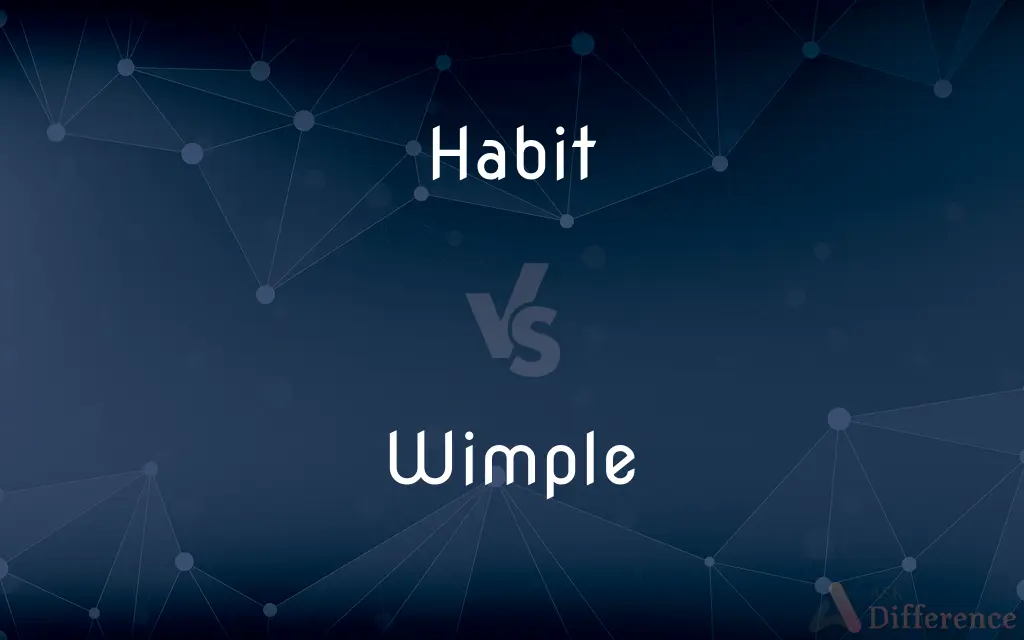Habit vs. Wimple — What's the Difference?
By Fiza Rafique & Maham Liaqat — Updated on April 4, 2024
Habits are repetitive behaviors often performed unconsciously, shaping personal routines, while wimples are traditional head coverings for women, symbolizing modesty.

Difference Between Habit and Wimple
Table of Contents
ADVERTISEMENT
Key Differences
Habits, in general, refer to recurrent behaviors or routines that individuals perform, often subconsciously, as part of their daily lives. These can range from simple actions like brushing teeth to complex patterns of social interaction. Habits play a crucial role in forming an individual's character and lifestyle, often being hard to break due to their ingrained nature in one's routine. They can be beneficial, like regular exercise, or detrimental, such as smoking.
Wimples, on the other hand, are specific to clothing and cultural tradition, being a form of head covering worn by women in various religious and historical contexts. Traditionally, a wimple is a cloth draped around the neck and head, leaving only the face exposed. It signifies modesty and, in some traditions, religious devotion. Unlike habits, which are behavioral and vary widely among individuals, wimples are a physical representation of cultural and religious values.
While habits are developed over time and can be altered with conscious effort, wimples are chosen as part of religious or cultural attire and can be adopted or removed at will. Habits form an integral part of one’s personality and daily life, reflecting personal choices and external influences. In contrast, wearing a wimple is often a matter of adherence to cultural or religious norms rather than personal habit or preference.
Habits and wimples also differ in their social and psychological implications. The formation of habits is a psychological process that can significantly impact an individual's health, well-being, and social interactions. Wearing a wimple, however, is primarily a social and cultural practice, reflecting broader societal values and individual beliefs about modesty and identity.
The distinction between habits and wimples underscores the difference between behaviors that shape personal identity and physical symbols that represent cultural or religious affiliation. While both play roles in defining individual and group identity, habits are more about personal routine and behavior, whereas wimples symbolize adherence to external cultural or religious standards.
ADVERTISEMENT
Comparison Chart
Definition
A repetitive behavior or routine performed by an individual.
A head covering worn by women, signifying modesty or religious devotion.
Nature
Psychological and behavioral.
Physical and symbolic.
Purpose
Forms an integral part of an individual’s daily life and character.
Represents cultural, religious values and modesty.
Changeability
Can be altered or broken with effort and awareness.
Can be adopted or removed at will, depending on cultural or religious context.
Social Implication
Reflects personal choices and psychological processes.
Indicates adherence to societal, cultural, or religious norms.
Compare with Definitions
Habit
An acquired mode of behavior that has become nearly or completely involuntary.
Biting nails is a common stress-induced habit.
Wimple
A garment signifying religious devotion or modesty.
Her wimple was a symbol of her commitment to her faith.
Habit
A behavior pattern acquired by frequent repetition.
Drinking coffee every morning is more of a habit than a necessity for her.
Wimple
A cloth worn over the head and around the neck and chin by women.
In medieval times, women wore wimples to denote modesty.
Habit
A customary practice or use.
It's his habit to read before sleeping.
Wimple
A traditional head covering for certain religious orders.
Nuns often wear a wimple as part of their habit.
Habit
A tendency to perform a particular action or type of behavior.
She has the habit of checking her phone the first thing in the morning.
Wimple
A headpiece that covers the head, leaving the face exposed.
Historical portraits show women wearing elaborate wimples.
Habit
A routine of behavior repeated regularly and often subconsciously.
Waking up at 6 a.m. has become his daily habit.
Wimple
A piece of cloth worn for cultural reasons.
She donned a wimple during the cultural festival to honor her heritage.
Habit
A habit (or wont as a humorous and formal term) is a routine of behavior that is repeated regularly and tends to occur subconsciously.The American Journal of Psychology (1903) defined a "habit, from the standpoint of psychology, [as] a more or less fixed way of thinking, willing, or feeling acquired through previous repetition of a mental experience." Habitual behavior often goes unnoticed in persons exhibiting it, because a person does not need to engage in self-analysis when undertaking routine tasks. Habits are sometimes compulsory.
Wimple
A wimple is a medieval form of female headdress, formed of a large piece of cloth worn around the neck and chin, and covering the top of the head. Its use developed in early medieval Europe.
Habit
A settled or regular tendency or practice, especially one that is hard to give up
He has an annoying habit of interrupting me
We stayed together out of habit
Good eating habits
Wimple
A cloth wound around the head, framing the face, and drawn into folds beneath the chin, worn by women in medieval times and as part of the habit of certain orders of nuns.
Habit
A long, loose garment worn by a member of a religious order
Nuns in long brown habits, black veils, and sandals
Wimple
A fold or pleat in cloth.
Habit
A person's health or constitution
A victim to a consumptive habit
Wimple
A ripple, as on the surface of water.
Habit
Be dressed or clothed
A boy habited as a serving lad
Wimple
A curve or bend.
Habit
A recurrent, often unconscious pattern of behavior that is acquired through frequent repetition
Made a habit of going to bed early.
Wimple
To cover with or dress in a wimple.
Habit
An established disposition of the mind or character
A pessimistic habit.
Wimple
To cause to form folds, pleats, or ripples.
Habit
Customary manner or practice
An early riser by habit.
Wimple
(Archaic) To form or lie in folds.
Habit
An addiction, especially to a narcotic drug.
Wimple
To ripple.
Habit
Characteristic appearance, form, or manner of growth, especially of a plant or crystal
"The habit of an apple tree is fine for the small garden" (Robert Dash).
Wimple
A cloth which usually covers the head and is worn around the neck and chin. It was worn by women in medieval Europe and is still worn by nuns in certain orders.
Habit
A distinctive set of clothing or style of dressing, especially of a religious order.
Wimple
A fold or pleat in cloth.
Habit
A riding habit.
Wimple
A ripple, as on the surface of water.
Habit
(Archaic) Physical constitution.
Wimple
A curve or bend.
Habit
To clothe; dress.
Wimple
A flag or streamer.
Habit
To clothe in a habit, especially a nun's habit.
Wimple
To cover with a wimple.
Habit
An action performed on a regular basis.
It’s become a habit of mine to have a cup of coffee after dinner.
Wimple
To draw down; to lower, like a veil.
Habit
An action performed repeatedly and automatically, usually without awareness.
By force of habit, he dressed for work even though it was holiday.
Wimple
To cause to appear as if laid in folds or plaits; to cause to ripple or undulate.
The wind wimples the surface of water.
Habit
A long piece of clothing worn by monks and nuns.
It’s interesting how Catholic and Buddhist monks both wear habits.
Wimple
To flutter.
Habit
A piece of clothing worn for a specific activity; a uniform.
The new riding habits of the team looked smashing!
Wimple
A covering of silk, linen, or other material, for the neck and chin, formerly worn by women as an outdoor protection, and still retained in the dress of nuns.
Full seemly her wympel ipinched is.
For she had laid her mournful stole aside,And widowlike sad wimple thrown away.
Then Vivian rose,And from her brown-locked head the wimple throws.
Habit
(archaic) Outward appearance; attire; dress.
Wimple
A flag or streamer.
Habit
Form of growth or general appearance and structure of a variety or species of plant or crystal.
Wimple
To clothe with a wimple; to cover, as with a veil; hence, to hoodwink.
This wimpled, whining, purblind, wayward boy.
Habit
An addiction.
He has a 10-cigar habit.
Kick the habit
Wimple
To draw down, as a veil; to lay in folds or plaits, as a veil.
Habit
(transitive) To clothe.
Wimple
To cause to appear as if laid in folds or plaits; to cause to ripple or undulate; as, the wind wimples the surface of water.
Habit
To inhabit.
Wimple
To lie in folds; also, to appear as if laid in folds or plaits; to ripple; to undulate.
For with a veil, that wimpled everywhere,Her head and face was hid.
With me through . . . meadows stray,Where wimpling waters make their way.
Habit
The usual condition or state of a person or thing, either natural or acquired, regarded as something had, possessed, and firmly retained; as, a religious habit; his habit is morose; elms have a spreading habit; esp., physical temperament or constitution; as, a full habit of body.
Wimple
Headdress of cloth; worn over the head and around the neck and ears by medieval women
Habit
The general appearance and manner of life of a living organism.
Habit
Fixed or established custom; ordinary course of conduct; practice; usage; hence, prominently, the involuntary tendency or aptitude to perform certain actions which is acquired by their frequent repetition; as, habit is second nature; also, peculiar ways of acting; characteristic forms of behavior.
A man of very shy, retired habits.
Habit
Outward appearance; attire; dress; hence, a garment; esp., a closely fitting garment or dress worn by ladies; as, a riding habit.
Costly thy habit as thy purse can buy.
There are, among the statues, several of Venus, in different habits.
Habit
The distinctive clothing worn commonly by nuns or monks; as, in the late 1900's many orders of nuns discarded their habits and began to dress as ordinary lay women.
How use doth breed a habit in a man!
He who reigns . . . upheld by old repute,Consent, or custom
Habit
To inhabit.
In thilke places as they [birds] habiten.
Habit
To dress; to clothe; to array.
They habited themselves like those rural deities.
Habit
To accustom; to habituate.
Habit
An established custom;
It was their habit to dine at 7 every evening
Habit
A pattern of behavior acquired through frequent repetition;
She had a habit twirling the ends of her hair
Long use had hardened him to it
Habit
(religion) a distinctive attire (as the costume of a religious order)
Habit
Excessive use of drugs
Habit
Put a habit on
Common Curiosities
What is a habit?
A habit is a routine behavior that is repeated regularly and often done subconsciously.
What is a wimple?
A wimple is a cloth covering worn over the head by women, traditionally symbolizing modesty or religious devotion.
What's the difference between a habit and a routine?
A habit is a behavior performed automatically, while a routine is a series of actions regularly followed but with more conscious thought.
Why do women wear wimples?
Women wear wimples for reasons of modesty, religious devotion, or adherence to cultural traditions.
Are all habits bad?
No, habits can be either beneficial, like exercising, or detrimental, such as smoking, depending on their nature.
Can habits be changed?
Yes, habits can be changed or broken with conscious effort and strategies aimed at altering behavior patterns.
How do habits form?
Habits form through repeated behavior over time, becoming automatic or subconscious actions.
Do all nuns wear wimples?
Not all nuns wear wimples; it depends on the specific rules of their religious order and cultural practices.
How long does it take to form a habit?
The time it takes to form a habit can vary greatly, often cited as anywhere from 21 days to several months, depending on the complexity of the behavior and individual differences.
What role do habits play in personal development?
Habits play a crucial role in personal development, shaping daily routines, influencing behavior, and ultimately determining aspects of an individual's character and lifestyle.
Can wimples be fashionable?
Yes, in some contexts, wimples can be adapted into fashion, blending traditional significance with modern style elements.
Can anyone wear a wimple?
While traditionally associated with certain religious orders or cultural practices, anyone can wear a wimple if they choose to do so for personal reasons.
Is wearing a wimple required in some religions?
Yes, in some religions or within certain denominations, wearing a wimple is required or strongly encouraged for women.
How do cultural perceptions of wimples vary?
Cultural perceptions of wimples vary widely, from symbols of oppression in some contexts to expressions of faith and modesty in others.
Can habits affect mental health?
Yes, certain habits, especially those related to lifestyle and thought patterns, can significantly impact mental health, both positively and negatively.
Share Your Discovery

Previous Comparison
Kielbasa vs. Linguica
Next Comparison
Beryl vs. TopazAuthor Spotlight
Written by
Fiza RafiqueFiza Rafique is a skilled content writer at AskDifference.com, where she meticulously refines and enhances written pieces. Drawing from her vast editorial expertise, Fiza ensures clarity, accuracy, and precision in every article. Passionate about language, she continually seeks to elevate the quality of content for readers worldwide.
Co-written by
Maham Liaqat













































